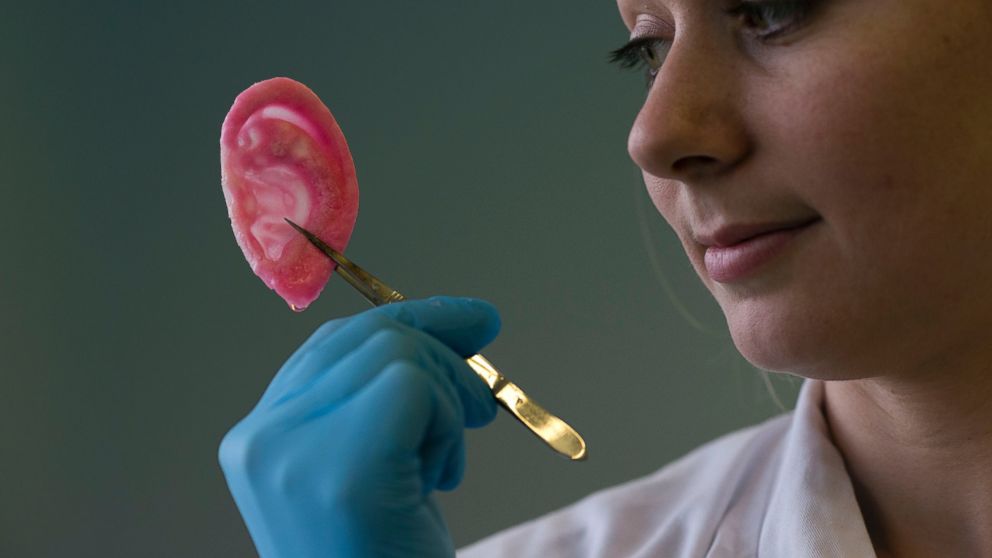New Technology Generates These Man-Made Body Parts
Man-made organs have gone from science fiction to fact.

April 11, 2014 — -- intro: Man-made (or “lab-grown”) organs have gone from science fiction to fact in recent years. While lab-grown ears have become famous thanks to the striking picture of a mouse with an ear grown on its back, recent technology, including 3-D printing and stem cell use, has meant more complex organs are being made by scientists.
Everything from ears to tracheas and, most recently, vaginas has been recreated in a lab setting. But doctors have also refined old-fashioned surgical techniques to give patients who have been disfigured a second nose or even a face through operations.
To show just how far this seemingly fantastical medicine has come, we’ve found a few of the most impressive man-made body parts.
quicklist: 1category: Man-Made and Lab-Grown Organstitle: Vaginatext:
A study published this week in the Lancet Medical Journal revealed how researchers were able to “grow” vaginas in a laboratory setting.
Researchers from Wake Forest University School of Medicine in Winston-Salem, N.C., and Metropolitan Autonomous University in Mexico City took tissue samples from four adolescent female patients from Mexico between the ages of 13 and 18, and then were able to construct vaginal components by culturing and expanding tissues in special incubators.
The patients, who were born with incomplete vaginas because of a genetic disorder, then underwent surgery and had the vaginal tissue implanted. In the years following the surgery, the patients reported normal sexual function.
media: 23294427
quicklist: 2category: Man-Made and Lab-Grown Organs title: Nose
text: In China, doctors were able to “regrow” a man’s nose. The twist is that they had to temporarily put the nose on the man’s forehead.
The patient identified as Xiaolian, according to Reuters, had an infection that left his nose damaged and disfigured.
To help him, doctors used tissue expanders and reshaped a second nose over a period of months on Xiaolian’s forehead. Eventually, when surgery is performed, they’ll use cartilage from his rib to help strengthen his nose.
Dr. Patrick Byrne, the director of Facial, Plastic and Reconstruction Surgery at Johns Hopkins Medical Center, said in the future he expects that doctors will transition to fully lab-grown organs.
”[We could] take a skin sample and some cells from the patient’s DNA and cartilage and use those cells to grow entire structure prior to reimplantation,” Byrne said.
Media: 20368218
quicklist: 3category: Man-Made and Lab-Grown Organstitle: Eartext: An ear grown on the back of a mouse is probably the most famous image of a lab-grown organ, but in recent years doctors have set aside the mouse in favor of the petri dish.
A lab in London has been making organs including ears. While previously doctors would recreate the ear surgically, they are now able to construct a polymer scaffold, which is then covered by stem cells and cultured until they blanket the scaffold. Eventually, they will test transplanting the ears onto a subject.
"Ears are harder to make than noses because you have to get all the contours right and the skin is pulled tight so you see its entire structure," Dr. Michelle Griffin, a plastic surgeon who has made dozens of ears and noses at the lab in University College London, told the Associated Press.
media: 23291076quicklist: 4category: Man-Made and Lab-Grown Organstitle: Tracheatext:Doctors were able to temporarily save a 2-year-old toddler last year by creating an artificial trachea for the girl.
Hannah Warren was born without a windpipe because of a rare genetic defect in South Korea. She had spent her entire life in the neonatal intensive care unit in Seoul, South Korea before being taken to the US for surgery.
To help Hannah, doctors in Chicago created a trachea composed of nonfiber mesh coated with cells extracted from Hannah’s bone marrow. Because they used her own cells, Hannah didn’t have to take difficult immune-suppressant drugs as she recovered.
Unfortunately, Hannah had other health issues that could not be overcome and she died a few months after the surgery.
media: 19607006
quicklist: 5category: Man-Made and Lab-Grown Organstitle: Face Text: While not exactly lab-grown, doctors were able to give a Chinese teenager, who had been scarred in a fire, a new face by utilizing tissue from her breast.
Xu Jianmei was badly burned in a fire as a child and left unable even to smile because of scar tissue. Doctors worked to reconstruct Jianmei’s face by utilizing skin from the teen’s breast to help reduce the scare tissue.
Over a period of months doctors used expanders to create more tissue and then transferred the tissue to help reconstruct Jianmei’s features. After the surgery, Jianmei could even smile again for the first time in over a decade.
media:23294303
The Associated Press contributed to this article.




